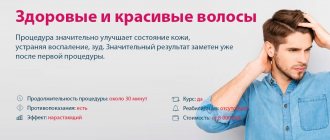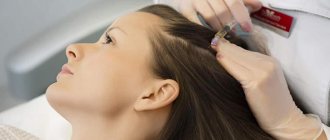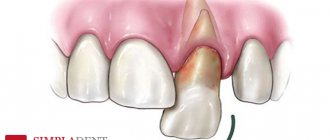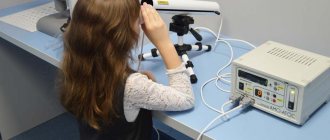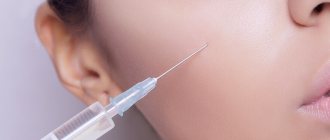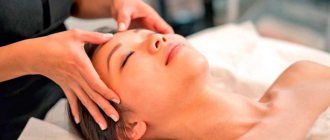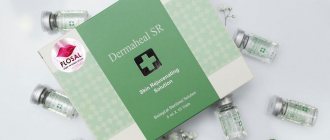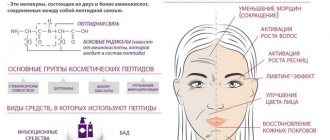Mesotherapy has successfully helped the third generation of women to delay the withering of the face and body by 10-15 years.
Men, thanks to these techniques, can fight to preserve their hair. Mesotherapy is a complex of subcutaneous injections with a cosmetic, aesthetic, therapeutic or corrective effect. The method of administration of the medicinal cocktail and its composition depend on the purpose of the procedure.
What is mesotherapy
The procedure consists of intradermal administration of medicinal and vitamin preparations in low doses. This is a minimally invasive injection technique that allows you to eliminate many aesthetic problems of the face, body, and hair. After it, the skin is transformed, the skin becomes tightened and elastic.
Mesotherapy is carried out as a separate manipulation or part of cosmetic procedures. The drugs are administered with the thinnest needles to a depth of 1.5-13 mm, this depends on the area of work. At the age of 18 to 25 years, facial mesotherapy is more often performed to get rid of oily skin, acne and its consequences. After 25, it acts as a prevention of aging.
An improvement in skin condition is noted after the first session, but a course of treatment is required to solve aesthetic problems. The number of visits is selected individually. From 4 to 15 procedures may be required at intervals of 6-10 days. To get rid of cellulite, up to 15 sessions are required, to restore the oval of the face - up to 8, to eliminate bags under the eyes - up to 4.
Skin scarification
BµÃ·ÃÂýÃÂõúÃÂøþýýðàüõ÷þÃÂõÃÂðÿà¸ÃÂ, øûø ÃÂúðÃÂøÃÂøúðÃÂøÃÂ, þÃÂÃÂÃÂõÃÂÃÂà²Ã»ÃÂõÃÂÃÂàÿÃÂÃÂõü ýðýõÃÂõýøàûõÃÂàµÃ± ýþóþ úþúÃÂõùûàýð úþöàÿÃÂø à VALUE ¾Ã³Ã¾ ÃÂÿðÃÂõûÃÂ. › › þûÃÂÃÂðÃÂÃÂü òðûøúþü øûภñþûõõ ÃÂþòÃÂõüõýýÃÂüø úþÃÂüà VALUE úþÃÂþÃÂÃÂõ þñõÃÂÿõÃÂðàñþûõõ ó ûÃÂñþúþõ àThe ¼ÃÂàòõÃÂõÃÂÃÂò ò úûõÃÂúø úþöýþó þ ÿþúÃÂþòð.
àÃÂÃÂôàóûðòýÃÂàÿÃÂõøüÃÂÃÂõÃÂÃÂò àðúþù ÿÃÂþÃÂõôÃÂÃÂàò ÿõÃÂòÃÂàþÃÂõà ýð÷ÃÂòðÃÂàõõ ñõ÷ñþûõ÷ýàµÃ½Ã½Ã¾ÃÂÃÂàø ñþûõõ òÃÂÃÂþúøù úþüÃÂþÃÂàò ÃÂÃÂà A þÃÂõÃÂðÿøõù.
› ûõõ 30àüøý. ÃÂ÷ ÿþñþÃÂýÃÂàÃÂÃÂÃÂõúÃÂþò þÃÂüõÃÂà°ÃÂàÃÂþûÃÂúþ ÿþúÃÂðÃÂýõýøÃÂ.
áúðÃÂøÃÂøúðÃÂøàúþöø, úðú ø ÃÂàðýôðÃÂÃÂýÃÂàüõ÷þÃÂõÃÂðÿøÃÂ, ýð÷à½Ã°ÃÂðõàòÃÂà°ÃÂ. àÃÂõ÷ÃÂûÃÂÃÂðÃÂõ õóþ ÷ðúûÃÂÃÂõýøàKeywords:
- øýÃÂõýÃÂøòýÃÂù (þàôþ ôõÃÂàÃÂø ÿÃÂþÃÂõôÃÂÃÂ, ÃÂð÷ ò ôõÃÂÃÂÃÂàôýõÃà¹);
- ÷ðúÃÂõÿûÃÂÃÂÃÂøù ÃÂð ÷ð 30 ôýõù).
What is the difference between mesotherapy and biorevitalization
The methods are very similar, but differ in the composition of the agents and the method of administration. For biorevitalization, gel-like preparations based on hyaluronic acid are used. Due to their dense consistency, they fill obvious wrinkles well, so the procedure is recommended for people over 30 years old.
During mesotherapy, liquid cocktails that contain various substances are administered. The cosmetologist selects the composition taking into account skin problems, age, and wishes of the client. They may also contain hyaluronic acid , but its amount will be significantly less than for biorevitalization. Due to the liquid form of the drugs, it will not be possible to fill deep wrinkles and folds. Due to the multicomponent composition, the range of indications for mesotherapy is wider.
Mesotherapy and biorevitalization can be used as two complementary procedures. They help improve skin condition, but have a different spectrum of action.
Biorevitalization
Biorevitalization (translated as biorevitalization) is a technique for slowing down the processes of age-related changes in the skin and improving its quality through the introduction of intradermal injections of preparations based on native (unstabilized) high-molecular hyaluronic acid. The term was proposed in 2001 by Italian scientists A. Di Pietro and G. Di Sante, who developed the basic concept of the method.
Hyaluronic acid is a polysaccharide that is part of the connective, epithelial and nervous tissue of the human body; is an important component of the synovial fluid that fills the cavity of the joints, the vitreous body of the eye, the extracellular matrix, etc. It is most fully present in the skin structures: the dermis, hypodermal and basal layers of the epidermis. In the body of a middle-aged and average-weight person (70 kg), it is synthesized by fibroblasts in the amount of 15 grams, the metabolic rate is on average 5 g/day.
The main amount of HA is located in the connective tissue of the dermis between collagen and elastin fibers. Hyaluronic acid creates conditions for the fixed arrangement of these proteins, thereby ensuring the firmness and elasticity of the skin.
HA is responsible for retaining moisture in the skin: one hyaluronic acid molecule can bind up to a thousand water molecules.
In addition to maintaining the structure of the extracellular matrix and its hydration, HA is also involved in cell migration and proliferation (new formation).
In the skin, hyaluronic acid is produced by special cells, fibroblasts. In humans at a young age, they function more actively and produce a sufficient amount of HA. But closer to the age of 30, its production gradually decreases, and in addition, the natural process of destruction of hyaluronic acid under the influence of hyaluronidase enzymes intensifies. This, in turn, negatively affects the functioning of fibroblasts, their number and activity decrease, the first signs of aging begin to appear: the skin becomes thinner and its turgor decreases, the uniformity of complexion is lost, and wrinkles appear.
Figure 1. Graph of decrease in GC concentration with age
The problem of deterioration in the synthesis of hyaluronic acid in tissues can also arise at a young age in those who take certain medications, have certain diseases, as well as bad habits (for example, smoking), eat poorly, live in an unfavorable environmental environment, etc. In addition, the amount of HA decreases sharply with intense exposure to sunlight.
What properties of hyaluronic acid have made it so popular in aesthetic medicine?
- Firstly, HA has high hygroscopicity (the ability to bind water) and maintains the water balance of the skin.
- Secondly, HA has a biostimulating effect: saturation of tissues with injected hyaluronic acid stimulates the formation and activity of fibroblasts (due to this, the synthesis of collagen and elastin, as well as its own HA), normalizes microcirculation and enhances the antioxidant protection of the skin, protecting against damage by reactive oxygen species.
Thus, the introduction of hyaluronic acid with certain characteristics makes it possible to influence the cause of skin aging, activate its own regenerative mechanisms and create the necessary physiological environment for the proliferation of fibroblasts, neocollagenesis and the synthesis of other components of the extracellular matrix. Thanks to biorevitalization, the dermis is restructured, manifested by improved hydration, nutrition and elastic properties of the skin, and its external rejuvenation.
It should be noted that one to two weeks after administration, hyaluronic acid undergoes natural biodegradation, but during this time it manages to launch all the processes necessary for natural regeneration. The effect obtained from the procedure gradually increases due to the restoration of the physiological properties of tissues.
Biorevitalization has the following indications:
- dehydration (dryness) of the skin;
- skin aging, both natural and premature, caused by external provoking factors (illness, medication, bad habits, stress, environment, etc.);
- photoaging of the skin due to intense sun exposure;
- decreased skin turgor;
- dull, unhealthy skin color;
- prevention of all of the above;
- preparing the skin for hardware procedures, peelings, plastic surgeries and recovery after them;
- preparation for the summer period and rehabilitation after it;
- problematic skin, acne;
- acne scars.
Takeaway:
The main contraindications for the biorevitalization procedure include:
- period of pregnancy and lactation;
- hypersensitivity or allergy to preparations with hyaluronic acid;
- viral (herpes), fungal and bacterial skin infections;
- neoplasms (papillomas, moles, etc.) or their accumulation in injection areas (to avoid needle injury, which can cause their growth or degeneration);
- keloid scars in injection areas;
- acute infectious and inflammatory diseases;
- increased body temperature, fever;
- serious cardiovascular diseases;
- diabetes mellitus in the stage of decompensation;
- mental illness, epilepsy;
- oncological diseases;
- autoimmune diseases;
- bleeding disorders, taking anticoagulant drugs.
What hyaluronic acid is used in biorevitalizants?
- HA of non-animal origin, obtained biotechnologically using bacterial cultures that produce hyaluronic acid (this makes it possible to obtain HA with previously known characteristics and quality indicators, minimize the risk of allergic reactions to the drug and reduce the cost of the production process).
- HA with a high molecular weight, from 1 to 2.5–3 million Daltons, which ensures its optimal restructuring and antioxidant effect. With a molecular weight of less than 1 million Daltons, HA does not have time to stimulate fibroblast division. There are drugs on the market that contain low molecular weight fragments of HA in combination with vitamins, minerals, amino acids, peptides, polynucleotides, coenzymes, etc., but they are not biorevitalizants in the literal sense and rather belong to the category of meso-cocktails. Examples of such drugs are CURACEN (Japan Bio Products Co. LTD, Japan) and MESOCLASS Ageless Peptides & HA 1% (Dermatime, Spain).
- Unstabilized HA (in other words, natural, not chemically modified). Stabilized hyaluronic acid preparations have a different purpose. They are used for contouring (fillers) or skin rehydration (for long-term retention of water in tissues). The stabilizers present in them are not recognized by the cellular receptor through which HA interacts with fibroblasts. Consequently, stabilized hyaluronic acid preparations do not have the necessary biorevitalizing effect.
- HA with concentrations ranging from 1.1% to 2.2%. A lower concentration does not have a full biorevitalizing effect (it is simply too little), and a higher concentration makes the drug too dense.
- HA has a viscoelastic consistency (in the form of a gel). This is due to the fact that to trigger the division of fibroblasts, the presence of hyaluronic acid in the tissues is necessary for 10–14 days, which is only possible with the gel structure of the preparations.
Today there are many classic preparations for biorevitalization on the market. Let's list just a few of them.
- The Neohyal line of biorevitalizants (Hangzhou Singclean Medical Products Co., Hong Kong), including the following products: NEOHYAL BR soft (used for patients 25+, designed to smooth out fine wrinkles, reduce inflammation of oily skin, including acne stages I–II severity, prevention of the formation of post-acne scars), NEOHYAL BR light (used for patients 35+, helps increase skin turgor, smooth out medium-deep wrinkles, reduce the severity of post-acne scars), NEOHYAL BR medium (designed for patients 40+, “reinforces” wrinkles and atonic areas of the skin, reduces the severity of folds on the face, corrects post-acne scars).
- “Conturgel-KhPM” 0.5% and “Konturgel-KhPM” 1% (Medical Case™, Russia), for the production of which unmodified hyaluronic acid from the Japanese manufacturer SHISEIDO is used, which does not contain low molecular weight fractions and has an ideal molecular weight distribution.
- MESOHEAL+ (Koru Pharmaceuticals Co., Ltd., Republic of Korea) based on highly purified unstabilized hyaluronic acid. The drug is absolutely safe and most effective for rejuvenating and improving the quality of the skin of the face, neck, décolleté, shins, medial thighs, lateral buttocks, shoulder girdle, dorsum of the hands and feet, and anterior abdominal wall. Can be used without the risk of adverse or allergic reactions due to the three-phase purification process of HA.
- Teosyal Meso (Teoxane, Switzerland) is based on unstabilized hyaluronic acid at a concentration of 15 mg/g, the weight of which is 1 million Daltons, due to which the drug is perfectly absorbed into the skin.
- Amalian Balance (S&V Technologies AG, Germany) based on purified unstabilized hyaluronic acid 12 mg/ml, which effectively combats dryness and sagging skin of the face, lips, neck, décolleté and hands.
Pros and cons of mesotherapy
The main advantage is the safety and non-toxicity of the drugs used, which extremely rarely cause side effects. Other advantages:
- wide age range;
- combined with other cosmetic procedures;
- minimal list of contraindications;
- persistent, long-lasting effect;
- suitable not only for women, but also for men;
- performed on an outpatient basis.
One of the disadvantages is the need for several sessions - from 4 or more, which depends on the problem being solved. After injections, slight swelling and discomfort at the injection site are possible, but this should not be a cause for concern.
Post-acne syndrome
When correcting cicatricial changes in the skin using the REVI line, we are talking about a symptom complex of secondary rashes, which resulted in the formation of stagnant spots, post-inflammatory hyperpigmentation and scars (hypo- and normotrophic).
When correcting scars, the bottom of the scar is first subcised, then a drug is injected to fill the “void” formed when fibrous cords rupture and the bottom of the scar is raised (Fig. 5)
.
For correction, the drug REVI Strong , which, due to the high concentration of hyaluronic acid and trehalose, provides lasting results and tissue stimulation.
Recommended needle: 30G-13mm.
Volume of the drug: 1-2 ml.
Administration technique: papular, linear-retrograde.
Depth of injection: under the scar, in the area of congestive spots or post-inflammatory hyperpigmentation.
Protocol: 1 time per month 3-5 procedures. If necessary, combine with hardware techniques (laser resurfacing)/chemical peels (TCA).
Rice. 5.
Techniques for working with post-acne scars
What therapeutic effect does mesotherapy have?
The result is noted due to 2 factors: delivery of active components to the skin and the mechanical effect of the needle. At the injection site, many microtraumas appear, which trigger the production of their own elastin and collagen, as a result of which microcirculation and metabolic processes improve. Depending on the task and the composition of the cocktails, the following effects are noted:
- the elasticity and firmness of the skin increases;
- hair growth increases;
- the functioning of the sebaceous glands is normalized;
- Spider veins are eliminated and blood vessels are strengthened;
- dark circles and bags under the eyes disappear;
- The oval of the face is tightened, fine wrinkles and sagging skin are eliminated;
- pigment spots are eliminated;
- enlarged pores are narrowed, acne and its consequences are eliminated.
The cosmetic procedure smoothes out the “orange peel” and evens out the skin. It is effective in the presence of stretch marks, scars, scars due to stimulation of tissue regeneration.
Stages of development of osteochondrosis
As osteochondrosis develops, it goes through several stages, characterized by certain signs and symptoms. We will look at these stages below.
Usually, at the initial stage of development of the disease, only a slight smoothing of the lordosis of the neck is observed; patients experience pain that intensifies when turning and tilting the head, and they feel tension and rapid fatigue of the muscles in the back and lower back. At this stage, osteochondrosis can be cured without medication; it is enough to change your diet, do exercises and other activities.
At the second stage, instability is observed between the vertebrae, the patient begins to experience more intense pain, periodically radiating to the arms or shoulders, and pain also increases when turning and tilting the head. This occurs as a result of pinched nerves as the height of the intervertebral discs decreases. Patients begin to notice rapid fatigue, absent-mindedness, decreased performance levels, and headaches.
At this stage, the pain begins to intensify, it constantly occurs not only in the neck, but also in the shoulders, radiating into the arms. The arm muscles become weaker and numbness occurs as herniated intervertebral discs begin to form. In this case, diagnostics reveals low mobility of the cervical spine. Patients are concerned about dizziness and weakness.
READ MORE: Spinal cyst Wikipedia
Hernia of the cervical spine
At the final stage, the intervertebral discs are destroyed and replaced by connective tissue. The pathological process affects several segments of the ridge at once, which may be at different stages of destruction. Patients experience poor coordination, increased dizziness and pain, tinnitus and other disorders.
Areas of application of mesotherapy
The procedure can be used to eliminate aesthetic problems on any part of the body. Mesotherapy application areas:
- Body.
- Face.
- Hair and scalp.
- Eyes (eyelids, area around the eyes, bags and dark circles under the eyes).
- Stomach.
- Neck.
- Chin.
- Hips, buttocks.
- Chest (neckline area).
- Hands.
- Legs.
- Back.
- Nose and nasolabial folds.
- Lips.
- Vessels.
The low invasiveness of the procedure allows it to be used even on areas with thin and sensitive skin. It can be combined with other therapeutic and surgical techniques within the framework of aesthetic medicine.
Mesotherapy shows high effectiveness for baldness. According to reviews of people who have undergone the procedure, after 10-13 sessions, activation of the hair follicles is noted.
Doing it at home
Mesotherapy can be carried out independently at home, which provides significant savings in time and money, however, it is important to comply with all conditions so as not to cause an infection, and also not to make a mistake with the choice of drug.
Step-by-step training for beginners:
- Disinfect the roller of the mesoscooter.
- Clean the problem area from dirt and makeup, if it is the face.
- Wipe with an antiseptic substance.
- Apply the medicinal product to the skin.
- Using slow, smooth movements with light pressure, roll the roller over the skin. If the procedure is performed on the face, then the direction of movement of the roller should be from the center of the forehead to the temples, from the eyebrows to the hair, on the cheeks - from the walls of the nose to the ears, from the center of the chin to the cheekbones.
- Wash off the drug 30-60 minutes after the session.
- Apply a soothing cream to the treated area.
- Disinfect the mesoscooter.
More information about how to carry out mesotherapy yourself is described in this video:
Mesotherapy is a very effective cosmetic procedure that allows you to solve many different problems associated with skin and hair without resorting to surgical interventions. A wide variety of techniques makes it possible to choose the most optimal one to eliminate a specific defect.
Indications and contraindications for mesotherapy
Mesotherapy is performed as a therapeutic and preventive procedure from the age of 18. This is a universal and effective manipulation that has a wide range of indications:
- rosacea;
- acne (acne vulgaris, rosacea);
- stretch marks;
- scars;
- bags, circles under the eyes;
- sagging, decreased skin tone;
- dark spots;
- wrinkles;
- swelling;
- oily, porous skin;
- cellulite;
- alopecia (hair loss).
Injections can serve as a preparatory step before other cosmetic procedures or during the recovery period after them. The procedure has a number of limitations:
- pathology of the coagulation system;
- intolerance to substances contained in the drug;
- pregnancy;
- tendency to form keloid scars;
- breast-feeding;
- period of exacerbation of chronic diseases;
- severe inflammatory process, fungal infection, open wounds in the work area.
Injection mesotherapy is not recommended when taking antiplatelet agents or anticoagulants due to their effect on the blood coagulation system. Time restrictions: menstruation, recent deep peeling, respiratory diseases.
Reviews from women
Mesotherapy has been around for over 50 years, which speaks to the proven, reliable and safe technique. You can read many reviews about nappage online. Studying them will allow you to choose the optimal type of mesotherapy.
We bring to your attention a few reviews:
Alevtina, 42 years old:
“I look very good for my age. Some consider this a miracle, but I am sure that this is nappage, which I do regularly, as well as 100% compliance with the recommendations of a good cosmetologist. I know everything about the attack because I had both a superficial and a deep procedure done. Once upon a time I started out of necessity, I needed to remove a scar in a visible place. I had a hard time believing that this was possible. It turned out that, and even more, mesotherapy can also actively combat wrinkles and other age-related problems.”
For information on the use of mesotherapy techniques, watch the video:
Lyudmila, 36 years old:
“I don’t know what was going on with my face, but it urgently needed intervention. It’s not that I’m aging, but my skin has become dull. I kept an eye on her, but she seemed completely unkempt. The cosmetologist suggested an attack. I did several procedures and did not recognize myself in the mirror. I started to look younger and brighter.”
Rita, 39 years old:
“I learned about the attack from a friend. She was getting younger before our eyes, by the way, after the divorce. I didn’t know what helped her more, cosmetology or freedom from family ties. I think it’s the former, since I also decided to try it and was shocked by the result. The scar on the cheek became almost invisible. The network of wrinkles has completely disappeared. It feels like 10 years have come back.”
A large number of statements have been written in this vein, which indicates the high effectiveness of the described area of mesotherapy.
Watch the video about the pros and cons of the procedure:
Mesotherapy techniques and methods
Methods differ in the method of administering drugs to the treated area:
- Pinpoint (“prick by prick”) is a classic, easy-to-perform technique. The drug is administered with a needle at a right angle to a depth of 4 mm at a distance of 1.5-2 cm.
- Nappage (“coating”) – quick injections at an angle to the surface of the skin. The needle is inserted to a depth of 1 to 4 mm, which depends on the type of nappage: superficial, middle or deep. The distance between injections is 3 mm.
- Papular. The needle is inserted at an angle to a depth of 1-2 mm to form small papules (tubercles).
- Linear. More often practiced for the treatment of scars and stretch marks. The needle is directed tangentially, the drug is injected retrogradely to fill the dermis under the wrinkle, fold of skin.
- Infiltration. It is used primarily to get rid of excess fat deposits (orange peel treatment). The needle is inserted to a depth of up to 13 mm every 2-2.5 cm.
In therapeutic mesotherapy, the continuous infusion technique is used to relieve pain in arthritis and arthrosis.
What techniques are best to use?
From the point of view of practicing cosmetologists, the most effective and easy-to-perform mesotherapy techniques include:
- superficial nappage;
- classical technique;
- papules;
- using a mesoscooter.
When choosing a technique, it is important to start not only from the simplicity of the method, but also from its purpose:
- for the treatment of dry or excessively oily skin, prone to rashes, acne, as well as in the presence of vascular problems, scars, it is better to choose between the nappage and papular method;
- Rosacea is treated with medium nappage;
- for hyperpigmentation on the face and body, they resort to the medium nappage technique;
- if pigmentation occurs due to prolonged exposure to sunlight, then you can try superficial nappage without treating the skin with any preparations (as an exception, applying an anti-pigment meso-cocktail is allowed)
- if there is swelling around the eyes, the appearance of fine wrinkles and other symptoms of skin aging in this area, it is better to stick to the classic technique;
- for alopecia or seborrhea, classic injections and superficial nappage will produce the greatest effect; You can find out about microcurrents for rosacea here.
- To restore damaged hair, the superficial papules technique is used;
- to lose weight and eliminate cellulite, it is necessary to administer lipolytic medications, which is most conveniently accomplished by the method of medium papules and infiltration;
- For stretch marks or severe ptosis, the linear-retrograde technique is used.
Positive results can only be achieved with the combination of the correct selection of anti-aging agents and mesotherapy techniques.
Types of mesotherapy
There are two types of procedure: injection and non-injection. In the first case, active substances are delivered to the skin using ultra-thin needles manually or using hardware. “Manual” mesotherapy allows you to work in the most delicate areas with thin skin, the drug is used sparingly.
Automatic injectors (guns) are suitable for working on a large area of skin (buttocks, thighs, abdomen, etc.). They facilitate and speed up manipulation, helping to quickly work on a large area in a short period of time. The device provides the exact depth of needle insertion and volume of the drug.
The second type of mesotherapy is the introduction of meso-cocktails without the use of needles. The active ingredients penetrate the skin through laser irradiation, magnetic and electric waves, and oxygen treatment. The method is ideal for people who want to undergo a rejuvenating procedure, but are afraid of injections.
Hardware therapy
To manually nourish the surface of the face and body with meso-cocktail, a cosmetologist will need a lot of effort and time. It is more convenient to carry out this procedure with an injector pistol.
The settings allow you to adjust the depth of the punctures and the volume of the injected drug, so any type of mesotherapy can be performed using the injector. The gun evenly and quickly processes large areas of the body at a given level.
In addition, there are non-injection hardware methods. They are based on the fact that a nutritional mixture applied to the skin penetrates deeply under the influence of various factors:
- high frequency currents;
- ultrasound;
- magnetic waves;
- tight air jets;
- laser
These procedures are painless, non-traumatic, and provide a long-lasting rejuvenating effect.
Complications, side effects and consequences of mesotherapy
An allergic reaction to the administered substances is possible, which can manifest itself as severe swelling of the skin, itching, and hives. Other negative effects:
- Pain. When the drugs are administered, there is pain and sometimes a burning sensation, which is associated with irritation of skin receptors. If necessary, the cosmetologist administers local anesthesia using gels.
- Redness. Normal reaction to injection. The redness disappears within half an hour, maximum after 2-3 hours.
- Bruises. They occur due to damage to blood vessels during the injection. They dissolve from 2 days to 2 weeks depending on the area of the skin , the condition of the vascular wall, and the degree of fragility of the blood vessels.
Minor swelling is possible - the body’s natural response to skin injury; it goes away on its own within 1-2 days.
Retrograde-linear method
This technique is more traumatic for subcutaneous tissues. The cosmetologist inserts a 12 mm needle into the middle layer of the skin parallel to its surface to a depth of 2-3 mm. Injects mesococktail evenly into the resulting channel with the reverse movement of the needle.
For the linear method, only the gel consistency of the active substances is used. The method is suitable for solving aesthetic problems: filling wrinkles, volume correction, smoothing out scars.
The retrograde technique comes in different types depending on the defect that needs to be corrected:
- tunnel, when the end of one channel coincides with the beginning of another (the needle moves along the fold of skin, filling it with filler);
- with the tracing method, the channels are pierced one after another with a short interval (suitable for smoothing out nasolabial wrinkles);
- the fan method is used to raise the line of the cheekbones or smooth out small creases in the corners of the mouth (from one puncture point, the channels are placed in different directions);
- The reinforcement straightens the networks of wrinkles around the eyes and fills the missing volume (for this, the channels are formed crosswise in relation to each other).
Preparations, remedies and medicines for mesotherapy
Taking into account the principle of action, mesotherapy drugs are divided into several groups: vitamin, vascular, lifting, anti-inflammatory, lipolytic. The composition may include:
- dimethylaminoethanol;
- lipolytics – liporcil, silicine, lopocat, phosphodithylcholine;
- vitamins – A, C, E, B;
- acids – glycolic, pyruvic, hyaluronic;
- plant extracts – aloe vera, green tea, guarana, artichoke;
- minerals – silicon, magnesium salts, zinc, selenium;
- antibiotics, anti-inflammatory drugs;
- extracts of animal origin - elastin, peptides, collagen, etc.
The specialist selects the composition of the cocktail individually, taking into account skin type, main problems, age and other factors.
Protocol selection tactics
I would like to note that no two patients are alike. Everyone has their own characteristics, skin condition, which is worth paying attention to.
When choosing a drug from the REVI line, we rely on the patient’s initial data and take into account the concentration of hyaluronic acid (HA) and trehalose in the composition.
REVI Style: HA 1%, trehalose 0.15%
REVI Silk: HA 1.2%, trehalose 0.25%
REVI Strong: HA 1.5%, trehalose 0.3%
REVI Eye correction HA 1%, trehalose 0.2%
Based on the experience of using REVI biorevitalizants in practice, protocols for their use have been developed, which make it possible to obtain pronounced results when working with both age-related changes and chronic dermatoses.
Indications for the use of the drugs are: age-related skin changes, dry, dehydrated skin, clinical manifestations of acne (acne I-II severity), rosacea, rosacea (erythematotelangiectatic form), hyperpigmentation, post-acne syndrome (normo- and hypotrophic scars).
Recommendations for patients
After the injections, the cosmetologist gives recommendations for the recovery period, which takes an average of 3-5 days:
- do not visit the sauna, bathhouse, solarium;
- do not sunbathe in the sun;
- do not perform peelings, massages and other procedures that involve mechanical impact on the skin;
- limit physical activity.
After the procedure, you should stop drinking alcoholic beverages, as they promote vasodilation. It is recommended to use sunscreen before going outside. In the first days, treat the skin with chlorhexidine and healing gels. Decorative cosmetics, especially foundation, should be discarded in the first 2 days so as not to irritate the skin and provoke inflammation.
It is not recommended to take blood thinning medications (aspirin, etc.) for 2 days after injections.
Carrying out the biorevitalization procedure (biocomplementary therapy)
Most often, biorevitalizants (classic and complex) are produced in a syringe, which is equipped with one or two needles. Some suppliers offer biorevitalizants in bottles of various sizes (up to 10 ml), this allows them to reduce the cost of the drug.
Most often, syringes with special hollow needles (Lebel needles) are used to administer biorevitalizants. They differ from conventional ones in their short length, 4–6 mm (which makes them more durable and allows them to work without constant control of the penetration depth), and a short, beveled edge.
Needles for biorevitalization come in lengths of 4, 6, 9, 13, 24 mm and various diameters, which are indicated on the packaging in G units, for example:
- 27G – 0.4 mm;
- 30G – 0.3 mm;
- 32G – 0.23 mm.
The choice of needle depends on the subsequent technique for administering the active substance.
As the procedure progresses, the needles become dull, so they need to be changed to minimize skin damage and pain for the patient. Recently, special needles with ultra-thin walls have been gaining popularity on the market, which not only make the injection procedure less painful, but also minimize trauma to the skin in the injection area and make it easy to administer solutions of high viscosity. True, the price of such needles is significantly higher than traditional ones. In any case, whatever needle you choose, it should have a high quality sharpening.
Also, some techniques for administering drugs for biorevitalization or biocomplementary therapy can be carried out using a flexible cannula. The advantage of the cannula is that from one injection point you can treat an area with a diameter of up to 4–5 cm, without injuring soft tissues or making multiple injections. Doctors recommend choosing a cannula with centimeter graduations, which will allow you to control the insertion range.
To administer biorevitalizants and drugs for biocomplementary therapy, the “papule” and linear-retrograde techniques are most often used with a needle, and the fan-retrograde technique is used with a cannula.
- “Papule” – the formation of intradermal “nodules” (papules) by injection to create a depot (prolonging the action) of the drug. Depending on the injection technique, papules may vary in diameter and depth of drug administration.
- The linear-retrograde technique consists of forming a linear channel in the dermis and uniformly filling it with the drug as the needle moves back.
- The fan-retrograde technique is similar to the linear-retrograde one, the difference is that the cannula is inserted in a certain direction (like one of the petals of a fan) to the required length, and the drug is supplied when the cannula is removed from the tissue.
Protocol for the biorevitalization procedure (biocomplementary therapy)
| Stages | |
| 1. Consultation with a cosmetologist, diagnosis of problems, preparation of medical documentation | Before the procedure, it is necessary to sign an agreement with the client for the provision of paid medical services and consent to the processing of personal data. As a rule, this document is prepared by the administrator of the salon or clinic. The doctor consults the patient on the issues and the recommended course of procedures, collects anamnesis, explains to the patient the nuances of the procedure and post-procedure care, fills out a medical record indicating the injection zones, administration technique, injection dose and name of the drug, and signs an informed consent with the patient for the procedure. . |
| 2. Allergy test | If there is a history of allergic reactions or suspicion of them, according to indications, the doctor conducts an allergy test for the patient: a very small amount of the drug is injected into the shoulder area. If there are no changes such as itching, redness, etc., you can proceed to the procedure. |
| 3. Preparation for the procedure | Before starting the procedure, the cosmetologist removes makeup and disinfects the skin using antiseptics. Mandatory preparation before the procedure involves application of anesthesia to the injection area. To do this, an anesthetic cream is applied under the occlusive film. Waiting time is on average 20–45 minutes. |
| 4. Administration of drugs | The drug must be opened by a doctor in the presence of the client. The packaging label (if any) must be affixed to the customer card. The time for administering the injections depends on the area of application of the procedure, on average about 30–40 minutes. |
| 5. Completion of the procedure | The injection sites should be treated with a disinfectant solution, such as chlorhexidine. The cosmetologist must once again tell the patient in detail about post-procedure care. All recommendations must be specified in the informed consent, a copy of which is given to the patient. |
Papules and linear grooves during the administration of drugs can increase their size by 1.5–2 times due to the attraction of water. They should regress no later than 48 hours after the procedure in the face and 72 hours in the décolleté and neck area.
If the technology for biorevitalization (biocomplementary therapy) is followed and contraindications to the procedure are taken into account, the likelihood of side effects is minimal. However, no one is 100 percent immune from the appearance of small bruises (hematomas). When they form, the doctor can prescribe the patient a local anti-inflammatory drug (for example, Traumeel S cream, Sinyak-off, etc.).
To speed up the rehabilitation process after the biorevitalization procedure (biocomplementary therapy) and prevent the occurrence of unwanted reactions, the patient must adhere to simple rules: do not use makeup and do not touch the treated area for 24 hours; do not visit the solarium, bathhouse, or sauna for at least two weeks; do not drink alcoholic beverages in the first days; avoid physical activity and increase fluid intake.
Where can you get mesotherapy in the Russian Federation?
Mesotherapy is one of the most popular procedures performed by cosmetologists in medical or cosmetology centers. When choosing a clinic, you need to pay attention to the availability of the necessary licenses to carry out this activity, as well as a diploma from a specialist.
Before mesotherapy, it is recommended to clarify which drug manufacturers the institution works with, view photos of the work, and a description of the procedure. The price of clinic services depends on the drugs used, the number of injections and the area of influence.
Mesotherapy is an effective cosmetic procedure. It solves a number of problems with skin and hair, while avoiding surgical intervention . The result can last up to 1.5 years; it is recommended to repeat the course once a year.
Biorevitalization in a beauty salon
Biorevitalization (biocomplementary therapy) can only be performed at an enterprise that has a medical license (Federal Law of May 4, 2011 No. 99 Federal Law “On Licensing of Certain Types of Activities”), which is issued by the Federal Service for Surveillance in Healthcare and Social Development. To carry out the procedure, a separate room with an area of at least 12 square meters is required. m according to the order of the Ministry of Health and Social Development of the Russian Federation dated April 18, 2012 No. 381n “On approval of the Procedure for providing medical care to the population in the field of cosmetology.”
We draw the attention of managers and directors of beauty salons that all drugs used for biorevitalization (biocomplementary therapy) must have a registration certificate (that is, they must be included in the relevant state registers). This is regulated by Decree of the Government of the Russian Federation dated December 27, 2012 No. 1416 “On approval of the Rules for state registration of medical devices” and articles 38 and 79 of the Federal Law dated November 21, 2011 No. 323-FZ “On the fundamentals of protecting the health of citizens in the Russian Federation.”
Biorevitalization (biocomplementary therapy) can be carried out by a cosmetologist or a specialist with secondary medical education (cosmetologist) as prescribed by a cosmetologist. However, in order to competently and correctly work with a particular drug, specialists must undergo short-term training (seminars) from the supplier company (distributor). Most often, the condition for training is the purchase of a drug (less often, training is simply paid). Examples of such workshops are presented in Table 1.
